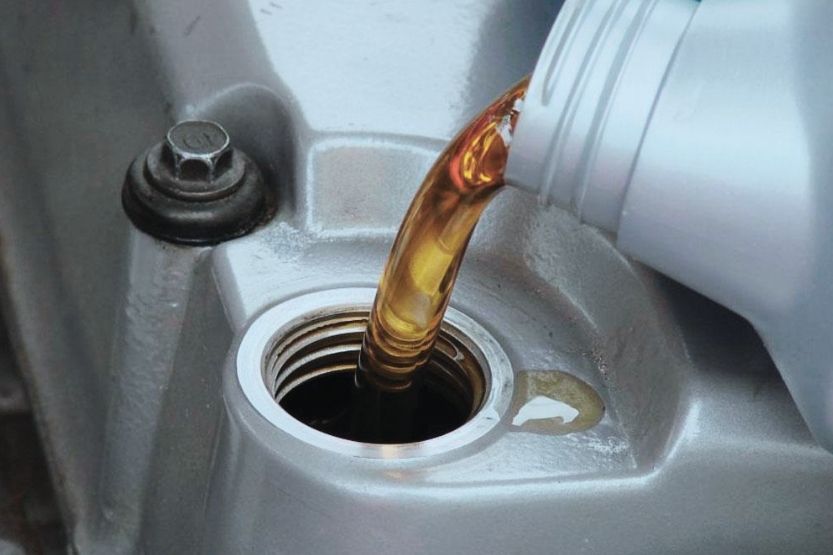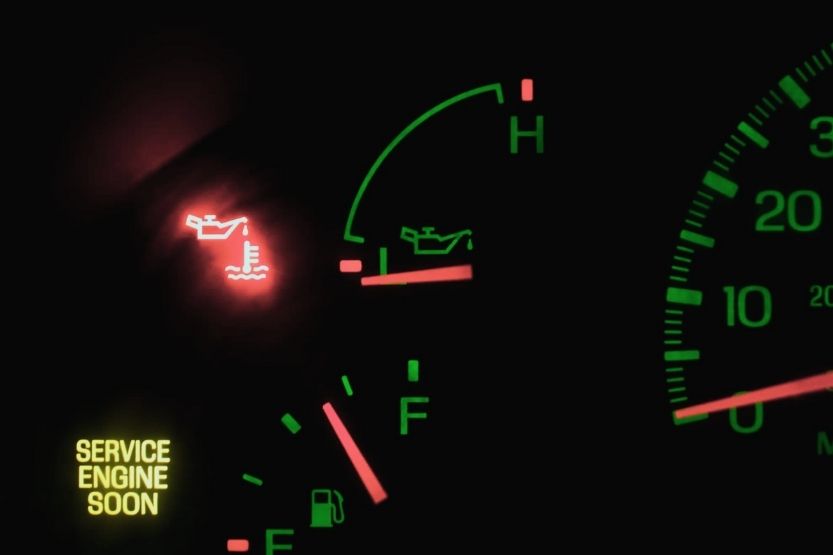It is always a frightening sight when one of the warning lights start going on your car’s dashboard. One of these lights would be the oil warning light. What does it mean when the oil light is flashing, and how can you fix it?
A flashing oil light could mean several things. The most likely cause might be that the engine oil is below the recommended level. It could also mean that the engine bearings are too worn down, which causes oil to leak.
Oil light flashing has the following causes:
- Low Oil Level or Worn-out Oil
- Excessive Engine Wear
- Faulty Gauge or Sensor
- Dirty Oil Filter
- Oil is Too Thick
- Engine Overheating
- Faulty Oil Pump
- Worn Valve Seals or Piston Rings
Read on to learn more about why the oil light is flashing and what steps to take to fix it.
Why Is the Oil Light Flashing?

Like the other warning lights on the dashboard, the check oil warning light directly connects to the car’s computer. When the sensors in the engine detect something is wrong with the oil, they send a signal to the computer. This is the reason why the oil light turns on and off.
The oil light turns on due to the low engine oil level. It could also mean that it is leaking out somewhere. You should always take your car to the mechanic for routine maintenance and inspection.
Here are some of the common reasons why the oil light is flashing. You will also learn here what you can do to fix them:
1. Low Oil Level or Worn-out Oil
Oil Change Every Six Months or 5,000 Miles
The key to a long-lasting vehicle is proper and regular maintenance. Therefore, the most important task you should not forget is giving your car a regular oil change. You need to give your vehicle a periodic oil change. Do it every six months or 5,000 miles, whichever comes first.
How to Fix
If your oil light turns on, do the following:
- Pullover to the side of the road.
- Turn off the engine.
- Then, let the engine cool down a bit.
- Check the oil dipstick.
- If the oil level is low, you should top it up before you resume driving.
- If there is a nearby gas station, go there immediately and get a small bottle.
On the other hand, immediately change the oil and oil filter if the oil is dirty. You will know that it is dirty if it is dark brown and has a thick consistency.
2. Excessive Engine Wear
Oil Must Move Through the Crankshaft and Camshaft Bearings
Oil must constantly move through the engine, mainly through the crankshaft and camshaft bearings. However, even if you change the oil regularly, you cannot avoid the wear and tear of the engine parts.
Loss in Oil Pressure
If the camshaft and crankshaft bearings have gotten too worn down, the oil will flow too easily through them. This will cause a loss in oil pressure, eventually leading to sensors sending an error message to the computer.
How to Fix
The only way to confirm and repair this problem is to take your car to a professional mechanic. Your mechanic will start running diagnostics.
If this confirms the problem with worn-down bearings, the only thing to do is open the crankcase. The goal here would be to replace the bearings. Your engine is in dire need of an overhaul.
3. Faulty Gauge or Sensor
Does your car have plenty of oil? Is it still in good condition but has an oil light that continues flashing? Then the trouble might be in the oil pressure sensors or gauge (if you have it).
Electrical Issue
If your oil pressure gauge is not working properly, it might be an electrical issue. Check the fuse box and look for the one used by the oil gauge. If busted, you have to replace it, and it should be working fine.
How to Fix
However, if it is not an electrical issue, you need to take the car to a mechanic. The mechanic will need to do a manual oil pressure check. This is to confirm whether or not there is indeed a lack of oil pressure.
4. Dirty Oil Filter
Clean Oil Is a Must for Proper Lubrication
Engine oil needs to circulate through the engine continuously. This is to make sure that every moving part has proper lubrication. Aside from that, it also lets the oil pass through the filter to get cleaned. Clean oil is necessary for the proper lubrication of engine parts.
Oil Pressure Buildup
If the oil filter has accumulated too much dirt, it will cause the oil pressure to build up. A pressure relief valve will let the oil go through unfiltered if the pressure is high. This will lead to the oil pressure dropping significantly.
How to Fix
You can prevent this from happening by routinely having your engine oil replaced. One of the tasks involved with every oil change package is replacing the oil filter. This will ensure that only clean oil will be coursing through your engine.
5. Oil Is Too Thick
High Viscosity Oil Works Great for Places with High Temperatures
If you use engine oil that is too dense, it might not flow as quickly as necessary. High viscosity oil works great at protecting the engine from high temperatures. However, if you live somewhere with a cold climate, this would work against you.
How to Fix
You can prevent this by only using the recommended oil viscosity as stated in your car’s user manual. This is necessary if you’ll be changing the oil yourself.
Typically, though, the technicians already know what engine oil is suitable for your car. This is when you get your oil changed at a service center.
6. Engine Overheating
If your engine is running too hot, it will cause the oil to lose viscosity significantly. It will not provide enough lubrication for the engine’s moving parts if it gets too thin. This results in them seizing. Worst-case scenario, the engine would get damaged too much that you will need to replace it entirely.
Keep the cooling system working properly to keep this expensive mistake from happening. Keep the engine coolant level at the recommended level to prevent the engine from overheating.
7. Faulty Oil Pump
This issue is not as common as the others on this list. However, you should not discount it as a reason for low oil pressure.
Not Properly Flowing Oil Can Trigger the Warning Light
When the oil is not flowing properly, it will trigger the oil warning light. It may also happen if the pump is malfunctioning. This is usually the case when the oil light is flashing when idle.
How to Fix
This makes it important to get your car checked by a mechanic if the oil warning light comes on. Do not continue using your car despite having a faulty oil pump. You will only be at risk of causing severe and expensive-to-fix damages later if you do.
8. Worn Valve Seals or Piston Rings
Causes Oil to Seep Into the Cylinders
These components prevent too much oil from getting into the combustion cylinders. If these components get too worn down or broken, the oil will start to seep into the cylinders. Aside from increasing your vehicle’s emissions, it will also decrease the oil circulating through the engine.
Signs of a Worn Valve Seal or Piston Ring
You can detect this problem if your muffler belches black smoke whenever you rev your engine. Another tell-tale sign is seeing oil splatters in your engine bay. Oil may also start dripping out of the engine case. If you see any of these signs, you need to immediately bring your car to your mechanic.
Stop Your Car
Whenever you see the oil warning light flash, you will need to stop your car. It would be like what you would do with a check engine light. Carefully pull over to the shoulder and shut off the engine. Once the engine cools down considerably, check the oil level.
Again, what does it mean when the oil light is flashing? If your car’s oil light is flashing and you hear a clicking sound, the oil might not be properly lubricating your car’s components.
How Long Can You Drive with the Change Oil Light On
How to Choose the Right Oil for Your Car

Regularly change the oil and oil filter to keep the oil light from turning on. This is one of the essential things that you need to do. Aside from getting an oil change, you also need to pick the right oil for your car.
Check the Owner’s Manual
There are many oil brands and types to choose from, so choosing one might seem difficult. However, it is quite simple. You have to check the owner’s manual of your car.
You will find all the details you need in the owner’s manual, such as the recommended oil weight (e.g., 10W-30). The number indicates the overall viscosity of the oil, wherein viscosity refers to the oil’s thickness or ability to flow at a certain temperature.
Adjust the Type of Oil Depending on the Climate
Just make sure to adjust the type of oil depending on the climate. The oil recommendation in the user manual will do fine for regular use. However, if you use the car in cold weather, go for a thinner oil. The reason is that it will not thicken as much.
Meanwhile, more viscous oil is better if you plan to use the vehicle in tropical weather. The reason is that it can protect your engine against extreme heat.
Why Are There So Many Different Motor Oils?
Even a small auto parts store will have many different automotive engine oils. You will find oils for the following:
- Modern engines,
- High-mileage vehicles,
- Imports,
- Heavy-duty machinery, and
- Off-road trucks.
Note that different vehicles and applications will require different viscosity oils.
The oil in your car’s user manual is recommended for a brand-new car. As your car advances in years, it will need thicker viscosity oil. This is to protect the critical engine parts from further wear and tear. It will also vastly improve its fuel economy as the engine can operate more efficiently.
How to Choose Among Synthetic, Semi-synthetic, High-mileage, and Conventional Motor Oils
There are different types of motor oils to choose from, but the most common categories are the following:
1. Premium Conventional Motor Oil
Standard Motor Oil Recommended for New Cars
This is the standard motor oil recommended for new cars. All the leading motor oil brands have this type of oil. It is available in different weights, too. Most automakers recommend using 5w-20 or 5w-30 oil weight for cold temperature use and 10w-30 for hotter climates.
Change the Oil and Oil Filter Every 4,000 Miles or Four Months
When using conventional motor oils, change the oil and oil filter every 4,000 miles or four months, whichever comes first. At the very least, change the oil twice a year. Moreover, follow its instructions if your car has an electronic oil-change reminder that flashes a message on your dash.
2. Fully Synthetic Motor Oil
More Suitable for Modern, Hi-tech Engines or Heavy-duty Vehicles
This type of motor oil is more suitable for modern, hi-tech engines or heavy-duty vehicles. Whether driving a ’22 Vette or an F-150 that regularly hauls trailers, go for fully synthetic oil.
Can Provide Long-lasting Protection Against Wear
Most full synthetic motor oils went through and passed stringent industrial testing. This is to ensure that they provide long-lasting protection against wear. These oils also flow better even at cold temperatures while providing optimal viscosity in hot climates.
Cost Almost Twice the Price of Conventional Motor Oils
If fully synthetic motor oils are so great, why aren’t more people using them? The most common reason is that it is just plain expensive. Some even cost almost twice the price of conventional motor oils. Also, not all engines need this kind of motor oil.
Your vehicle might need specific components found in other oil types not present in synthetic oils. Just because fully synthetic oils are expensive does not necessarily mean it is the best for your car. Again, it’s best to consult your owner’s manual for more details.
3. Synthetic Blend Motor Oil
Combination of Synthetic and Organic Oil
As the name suggests, this motor oil is a synthetic and organic oil blend. It comes formulated to provide somewhat similar protection to a fully synthetic oil but at a more affordable price. This engine oil is typically for vehicles with huge engine loads and operates at high temperatures.
Less Volatile Than Conventional Oils
Synthetic blend oils, also called semi-synthetic oils, are less volatile than conventional oils. This means they evaporate at a significantly slower rate compared to conventional oils.
Suitable for Trucks or SUVs
Folks with trucks or SUVs choose semi-synthetic motor oils. This engine oil protects the engine from the various stresses from off-roading. Also, as mentioned earlier, this is relatively cheap, often pennies more expensive than premium conventional oils.
4. High-mileage Engine Oil
Today’s vehicles can last longer than those manufactured for nearly a decade or two. Most people want to finish paying for their car and running it for many years. This can essentially get six figures on the odometer.
You might need to choose a high-mileage oil if you are like this. Around 2/3 of all vehicles, today have clocked more than 75k miles on their odometers. This has recently become an area of interest for engine oil manufacturers.
Do you have an older vehicle, something around five to ten years old? Then you might have noticed that a bit of engine oil has pooled on the floor of your carport.
This is due to the engine oil seeping through the minute cracks in the oil seals. After years of use, the once-flexible engine seals have hardened and brittle. This means they are more likely to crack.
Come with Additives That Treat the Engine Seals
High-mileage engine oils come with additives that treat the engine seals to restore some of their flexibility somehow. They are also much thicker than most fully synthetic oils. In other words, it can provide a better seal around the pistons. This can let them get more compression with every stroke.
Suitable for Cars Driven for Over 100k Miles
If you drive a car over 100k miles, the high-mileage engine oils are your best choice. This is especially true if you don’t have a fully synthetic oil change budget.
Frequently Asked Questions (FAQs)

Can I Still Drive My Car with the Oil Light On?
Yes. Unlike the check engine light, which needs immediate attention, the oil warning light is not as alarming. Depending on its reason for flashing, you may still drive around for 500 miles before it becomes a severe issue.
However, driving around with the oil warning light is generally not advisable. The reason is that it can quickly become a bigger problem. For instance, if your engine is leaking oil while still using the car, it may cause tremendous wear and tear.
If the check engine light doesn’t turn on before, it will light up after driving around too much. It will cause the oil warning light to turn on.
Why Is My Oil Light Flashing When the Engine Is Idle?
Are you sure that the oil level is at the recommended level and the oil light flashes when braking? Then the problem might be with the sensor. It could also be that the oil pressure is low. In any case, the only thing that you can do is bring your car to a mechanic to be sure.
Conclusion – Oil Light Flashing [Causes and How to Fix]
If you find the oil light flashing on your car’s dashboard, it could mean one of several things. These include the following:
- Low Oil Level or Worn-out Oil
- Excessive Engine Wear
- Faulty Gauge or Sensor
- Dirty Oil Filter
- Oil is Too Thick
- Engine Overheating
- Faulty Oil Pump
- Worn Valve Seals or Piston Rings
However, the most likely culprit for the warning light is that the engine oil is below the recommended level. One of the worst-case scenarios is that the engine bearings are too worn down, causing the oil to leak out.
Whatever causes your oil light to blink on and off in your dashboard, immediately take your car to the mechanic.
Read next:
Reset Honda Oil Maintenance Light





![Check Engine Light On and Off Intermittently [Causes and Fixes] check engine light on and off](https://roadsumo.com/wp-content/uploads/2021/06/check-engine-light-on-and-off-150x150.jpg)

![Read more about the article Who Makes Supertech Oil? [Walmart Supertech Synthetic Oil]](https://roadsumo.com/wp-content/uploads/2021/06/who-makes-supertech-oil-300x200.jpg)

![Read more about the article How Much Is an Oil Change at Jiffy Lube [Service Costs]](https://roadsumo.com/wp-content/uploads/2021/10/how-much-is-an-oil-change-at-jiffy-lube-300x200.jpg)